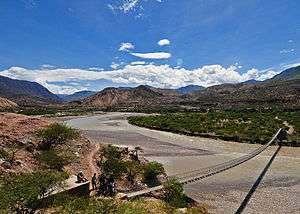Mantaro River
| Mantaro River | |
 | |
| Country | Peru |
|---|---|
| Tributaries | |
| - left | Cunas River |
| - right | Ichhu River, Kachimayu |
| Source | Lake Junin |
| Mouth | Ene River |
| - coordinates | 12°15′46″S 73°58′44″W / 12.26278°S 73.97889°WCoordinates: 12°15′46″S 73°58′44″W / 12.26278°S 73.97889°W |
| Length | 470 km (292 mi) [1] |
| Basin | 15,410 km2 (5,950 sq mi) |
 Map of large rivers in south-central Peru (only the lower section of Mantaro River is highlighted)
| |
The Mantaro River (Spanish: Río Mantaro, Quechua: Hatunmayu) is a long river running through the central region of Peru. Its Quechua name means "great river". The word "Mantaro" may be a word originally from the Ashaninka language, who live downstream along the Ene River. The Mantaro, along with the Apurimac River, holds the distinction of being the source of the Amazon River, depending on the criteria used for definition.[2]
Geography
The river nominally has its source at Lake Junin at a height of 4,080 m, but tributaries above Lake Junin extend as much as 70 km farther upstream, for a total length of 808 km. The river runs through the provinces Junín, Yauli, Jauja, Concepción and Huancayo in the Junín Region, then through the Huancavelica Region and the Ayacucho Region. The river then returns to the Junín Region in Satipo Province, where it unites with the Apurimac River to form the Ene River. Its hydrographic basin also includes some of the Pasco Region. The river belongs to the hydrographic basin of the Amazon River. Its principal tributaries are the Cunas River, the Vilca/Moya River, the Ichhu River, and the Kachimayu.
The river runs from northeast to southeast through the Mantaro Valley. This valley is the most important food source for the capital Lima.
The Mantaro Hydroelectric Complex is located in the Tayacaja Province of the Huancavelica Region, and produces 31% of all electrical energy generated in Peru.[3]
The first complete paddling descent of the river from the source was accomplished by Rocky Contos and James Duesenberry in May 2012.[4] Previously, the lower 140 km of the river were descended in cataraft by Richard Pethigal in 2002.[5] The lower section of the river is known for Sendero Luminoso camps.
Source of the Amazon
In 1971, an expedition led by the National Geographic Society cited the Apurimac River as the designated headwaters of the Amazon River, with a follow-up expedition in 2000 confirming the connected Lake Ticlla Cocha as the furthest upstream Amazon extension.[6] The definition for the distinction used at the time of survey was based on absolute length which the tributary added to the river, given a continuous and year-round flow of water. With the Tablachaca Dam built in 1974, a portion of the Mantaro River suffers a dry spell for five months of the year, previously excluding it from the list of source eligibility. However, research published in 2014 challenged this existing definition, and used advanced imaging and topographic data to establish the Mantaro as the true longest upstream source feeding into the Amazon Basin.[7] The new measurements add approximately 75–92 km to the original Amazon River length.
See also
Notes
- ↑ Ziesler, R.; Ardizzone, G.D. (1979). "Amazon River System". The Inland waters of Latin America. Food and Agriculture Organization of the United Nations. ISBN 92-5-000780-9. Archived from the original on 8 November 2014.
- ↑ Lee, Jane. "Where Does the Amazon River Begin?". National Geographic. Retrieved 14 February 2014.
- ↑ "Complejo Hidroenergético del Mantaro" (in Spanish). ElectroPeru.
- ↑ "First Descent of the Amazon Expedition". Retrieved 10 February 2013.
- ↑ "Rio Mantaro". Retrieved 10 February 2013.
- ↑ Lee, Jane. "Where Does the Amazon River Begin?". National Geographic. Retrieved 14 February 2014.
- ↑ Contos, James; Tripcevich, Nicholas (2014-02-12). "Correct placement of the most distant source of the Amazon River in the Mantaro River drainage". Area 46 (1): 27–39. doi:10.1111/area.12069. Retrieved 6 November 2015.
External links
| Wikimedia Commons has media related to Mantaro River. |